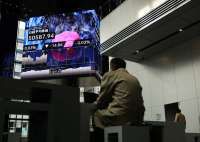ECONOMIC GROWTH - WASHINGTON. The U.S. economy maintained a strong pace of growth in the fourth quarter as consumers boosted spending on goods, but momentum appears to have slowed considerably towards the end of the year, with higher interest rates eroding demand.
Gross domestic product increased at a 2.9% annualized rate last quarter, the Commerce Department said in its advance fourth-quarter GDP growth estimate on Thursday. The economy grew at a 3.2% pace in the third quarter. Economists polled by Reuters had forecast GDP rising at a 2.6% rate.
That could be the last quarter of solid growth before the lagged effects of the Federal Reserve's fastest monetary policy tightening cycle since the 1980s kick in. Most economists expect a recession by the second half of the year, though mild compared to previous downturns.
Retail sales have weakened sharply over the last two months and manufacturing looks to have joined the housing market in recession. While the labor market remains strong, business sentiment continues to sour, which could eventually hurt hiring.
Read Also: Shares in Asia Hit Fresh 7-Month High, U.S. GDP Data Awaited
Robust second-half growth erased the 1.1% contraction in the first six months of the year. For all for 2022, the economy expanded 2.1%, down from the 5.9% logged in 2021. The Fed last year raised its policy rate by 425 basis points from near zero to a 4.25%-4.50% range, the highest since late 2007.
Consumer spending, which accounts for more than two-thirds of U.S. economic activity, was the main driver of growth, mostly reflecting a surge in goods spending at the start of the quarter. Spending has been underpinned by labor market resilience as well as excess savings accumulated during the COVID-19 pandemic.
But demand for long-lasting manufactured goods, which are mostly bought on credit, has fizzled and some households, especially lower income, have depleted their savings. Business spending also lost some luster as the fourth quarter ended.
Read Also: Indonesian C.Bank's Expanded Mandate Won't Affect Inflation Framework - Chief
ROLLING RECESSION
Despite the clear signs of a weak handover to 2023, some economists are cautiously optimistic that the economy will skirt an outright recession, but rather suffer a rolling downturn, where sectors decline in turn rather than all at once.
They argue that monetary policy now acts with a shorter lag than was previously the case because of advances in technology and the U.S. central bank's transparency, which they said resulted in financial markets and the real economy acting in anticipation of rate hikes.
Residential investment suffered its seventh straight quarterly decline, the longest such streak since the collapse of the housing bubble triggered the Great Recession, but there are signs the housing market could be stabilizing.
Mortgage rates have been trending lower as the Fed slows the pace of its rate hikes.
A separate report from the Labor Department on Thursday showed initial claims for state unemployment benefits dropped 6,000 to a seasonally adjusted 186,000 for the week ended Jan. 21. The number of people receiving benefits after an initial week of aid, a proxy for hiring, increased 20,000 to 1.675 million for the week ended Jan. 14.
Companies outside the technology industry as well as interest-rate sensitive sectors like housing and finance are hoarding workers after struggling to find labor during the pandemic.
/2021/06/16/1407482536p.jpg)









